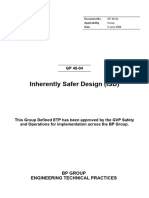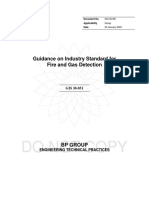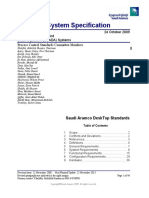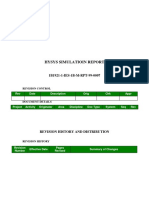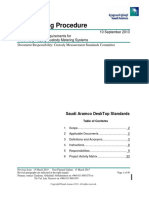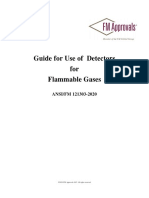Saes J 505
Saes J 505
Uploaded by
aaaCopyright:
Available Formats
Saes J 505
Saes J 505
Uploaded by
aaaOriginal Title
Copyright
Available Formats
Share this document
Did you find this document useful?
Is this content inappropriate?
Report this DocumentCopyright:
Available Formats
Saes J 505
Saes J 505
Uploaded by
aaaCopyright:
Available Formats
Engineering Standard
SAES-J-505 12 April 2020
Combustible Gas and Hydrogen Sulfide in Air Detection Systems
Document Responsibility: Instrumentation Standards Committee
Contents
Summary of Changes .............................................. 2
1. Scope ................................................................. 3
2. Conflicts and Deviations ..................................... 3
3. References ......................................................... 3
4. Terminology........................................................ 4
5. Design ................................................................ 6
6. System Description ............................................ 7
7. Alarm Requirements......................................... 11
8. Electrical Requirements ................................... 14
9. Installation ........................................................ 14
10. Gas Detection System Aging Characteristics ... 15
Document History .................................................. 16
Previous Revision: 23 December 2019 Next Planned Revision: 23 December 2024
Contact: GHAMSM06 Page 1 of 16
©Saudi Aramco 2019. All rights reserved.
Saudi Aramco: Company General Use
Document Responsibility: Instrumentation Standards Committee SAES-J-505
Publish Date: 12 April 2020
Next Planned Update: 23 December 2024 Combustible Gas and Hydrogen Sulfide in Air Detection Systems
Summary of Changes
Change Type
Paragraph (modification, Technical Change
addition, deletion)
1 10 deletion Deleted section 10
2 6.4.2.1 modification Clarify on single and multi-channel controller
Saudi Aramco: Company General Use Page 2 of 16
Saudi Aramco: Company General Use
Document Responsibility: Instrumentation Standards Committee SAES-J-505
Publish Date: 12 April 2020
Next Planned Update: 23 December 2024 Combustible Gas and Hydrogen Sulfide in Air Detection Systems
1. Scope
This standard defines the minimum mandatory requirements governing the design and
installation of fixed hydrogen sulfide and combustible gas-in-air monitoring systems for
personnel and plant protection.
2. Conflicts and Deviations
Any conflicts between this document and other applicable Mandatory Saudi Aramco
Engineering Requirements (MSAERs) shall be addressed to the EK&RD Coordinator.
Any deviation from the requirements herein shall follow internal company procedure
SAEP-302.
3. References
The selection of material and equipment, and the design, construction, maintenance, and
repair of equipment and facilities covered by this standard shall comply with the
applicable parts of the latest editions of the references listed below, unless otherwise
noted.
3.1 Saudi Aramco References
Saudi Aramco Engineering Procedure
SAEP-302 Waiver of a Mandatory Saudi Aramco Engineering
Requirement
Saudi Aramco Engineering Standards
SAES-B-054 Access, Egress, and Materials Handling for Plant
Facilities
SAES-B-062 Onshore Wellsite Safety
SAES-J-003 Instrumentation and Control Buildings - Basic Design
Criteria
SAES-J-510 Process Analyzer System
SAES-J-902 Electrical Systems for Instrumentation
SAES-K-002 Air Conditioning Systems for Essential Operating
Facilities
SAES-K-502 Combustion Gas Turbines
SAES-P-100 Basic Power System Design Criteria
Saudi Aramco Materials System Specifications
23-SAMSS-010 Distributed Control Systems
23-SAMSS-030 Remote Terminal Units
34-SAMSS-514 Combustible Gas and Hydrogen Sulfide Monitors
Saudi Aramco: Company General Use Page 3 of 16
Saudi Aramco: Company General Use
Document Responsibility: Instrumentation Standards Committee SAES-J-505
Publish Date: 12 April 2020
Next Planned Update: 23 December 2024 Combustible Gas and Hydrogen Sulfide in Air Detection Systems
34-SAMSS-623 Programmable Controller Based ESD Systems
3.2 Industry Codes and Standards
International Society for Measurement and Control
ANSI/ISA-60079-29-1 Explosive Atmospheres - Part 29-1: Gas Detectors
- Performance Requirements of Detectors for Flammable
Gases
ANSI/ISA-60079-29-2 Explosive Atmospheres - Part 29-2: Gas Detectors
- Selection, Installation, Use and Maintenance of
Detectors for Flammable Gases and Oxygen
ANSI/ISA-92.00.01 Performance Requirements for Toxic Gas Detectors
ANSI/ISA-92.00.02 Installation, Operation, and Maintenance of Toxic Gas-
Detection Instruments
ANSI/ISA-12.13.04 Performance Requirements for Open Path Combustible
Gas Detectors
ANSI/ISA 92.00.04 Toxic Open Path Detector
National Fire Protection Agency
NFPA 72 National Fire Alarm Code
4. Terminology
Attended Facility: Facility with 24-hour-per-day operation and where personnel are
continuously in attendance.
Control Building: A structure which contains process control equipment. It may be an
operator shelter, a process interface building, or a central control room.
Combustible Gas: A gas which can form an ignitable mixture
(as defined in SAES-B-006) with air.
DCS: Distributed Control System (DCS): A process control system that is
composed of distinct modules. These modules may be physically and functionally
distributed over the plant area. The distributed control system contains all the modules
and associated software required to accomplish the regulatory control and monitoring of
a process plant, excluding field instruments, remote terminal units, auxiliary control
systems, and plant information systems.
Dual Modular Redundant (1oo2D) ESD System: An ESD system which uses two
separate processors each with its own separate I/O modules, bus structure, chassis,
software and power supplies, to vote input signals in a 1oo2 arrangement.
Sensor signals are separated into two isolated paths to two separate input modules
where signals are conditioned and communicated by separate busses to separate
processors. A valid input signal on either leg of the system will initiate the desired
logic response via two separate, fail-safe, output modules.
Saudi Aramco: Company General Use Page 4 of 16
Saudi Aramco: Company General Use
Document Responsibility: Instrumentation Standards Committee SAES-J-505
Publish Date: 12 April 2020
Next Planned Update: 23 December 2024 Combustible Gas and Hydrogen Sulfide in Air Detection Systems
Electrochemical Cell (EC): Electrochemical cell converts gas concentration to
electrical current. Molecules of the target gas react on the sensing electrode and
generate current.
Enhanced Laser Diode Spectroscopy (ELDS): Laser light at a specially selected
wavelength for the target gas, is generated by a transmitter and projected over an open
area to a receiver. The receiver processes the light signal and calculates the gas
concentration
Emergency Shutdown System (ESD): A system composed of sensors, logic solvers,
and final control elements for the purpose of taking the process, or specific equipment
in the process to a safe state when predetermined conditions are violated, i.e., to isolate,
de-energize, shutdown or de-pressure a process unit or process equipment. Other terms
commonly used throughout the hydrocarbon and petrochemical industry include Safety
Instrumented and Safety Interlock Systems (SIS).
Fail-safe State: The condition to which an instrument or system shall revert upon loss
of power, logic signal or motive force. Unless otherwise specified, the fail-safe state for
a normally energized safety system shall be the de-energized state, with no power or
logic voltage being applied to an element or final operator.
Foundation Fieldbus: A digital communication protocol, used for detector
communication to the control systems, as an alternative to 4–20 mA.
IR: This method for measuring gas concentration is based on the absorption of IR
Infrared radiation at gas-specific wavelengths in a volume containing the target gas.
Lower Explosive Limit (LEL): This is the minimum concentration of a gas in a
gas/air mixture at which the mixture will explode if exposed to an ignition source.
Open Path Detector: A type of gas detector with two parts; sender and receiver.
IR and Laser are the common open path detectors.
Parts per Million (PPM): A unit of measurement used for small portions or
concentrations. In gas analysis, it expresses the volume of gas present in terms of its
relationship to a whole of 1 million parts of air. 1% = 10,000 ppm. 1% of volume =
10,000 ppm, 100% of volume=1,000,000 ppm.
Programmable Logic Controller (PLC): A digital, electronic controller, designed for
use in an industrial environment. A PLC uses a programmable memory for the internal
storage of user-oriented instructions for implementing specific functions to control,
through digital or analog inputs and outputs, various types of machines or processes.
Remote Terminal Unit (RTU): A microprocessor-based logic solver that monitors
remote field digital and analog parameters and transmits data over a wired or wireless
network to a master monitoring system, such as a Distributed Control System (DCS) or
a Supervisory Control and Data Acquisition (SCADA) system. A Remote Terminal
Unit is equipped with input modules for sensing or metering, output modules for
control, indication or alarms and communications port(s). It also contains setup
software to connect data input streams to data output streams, define communication
protocols, and troubleshoot installation problems.
Rupture Exposure Radius (RER): For toxic effects, the rupture exposure radius
refers to the horizontal distance from a leak source to a specified level of hydrogen
Saudi Aramco: Company General Use Page 5 of 16
Saudi Aramco: Company General Use
Document Responsibility: Instrumentation Standards Committee SAES-J-505
Publish Date: 12 April 2020
Next Planned Update: 23 December 2024 Combustible Gas and Hydrogen Sulfide in Air Detection Systems
sulfide (H2S) concentration in parts per million (ppm). For a flammable gas hazard, the
rupture exposure radius refers to the horizontal distance from a leak source to the ½
Lower Flammable Limit (LFL).
Triple Modular Redundant (TMR) System: An emergency or safety shutdown
system which employs a 2-out-of-3 (2oo3) voting scheme to determine appropriate
output action, based on the application of three separate processors with triplicate inputs
and outputs (I/O) components and bus structure, with all systems running in parallel.
Unattended Facility: Facility with one shift operation, two shift operation or
unmanned stations.
5. Design
5.1 General
5.1.1 Fixed gas detection systems shall measure and provide alarms at the specified
concentrations of combustible gas or hydrogen sulfide in air.
The system shall be designed to provide an immediate response to an alarm
situation and to prevent unauthorized system bypass or alarm reset. The
response times of the detectors shall be per ANSI/ISA- 92.00.02-2013,
ANSI/ISA-12.13.04and ANSI/ISA-60079-29-2.
5.1.2 The design shall allow for each gas detector (sensor) to be accurately and
effectively tested or calibrated at regular periods. The system design shall
provide the means for testing each detector without disabling the entire system
or causing accidental shutdown of equipment as per ANSI/ISA- 92.00.02, and
ANSI/ISA-60079-29-2.
5.1.4 The system shall comprise one or more detectors connected to a control unit or
logic system (as specified in sections 6.4.2 and 6.4.3) to provide audible and
visible alarms in the field and in attended control buildings.
5.1.5 The system shall not be used to automatically initiate a shutdown of process
equipment. Automatic shutdown of building ventilation systems shall be in
accordance with SAES-K-002, “Air Conditioning Systems for Essential
Operating Facilities.” Also, gas detection can be used to shut down combustion
gas turbine generators.
Exception:
A H2S gas detection system shall be used to shut down producing
wells near population if a dispersion model shows that the 30 PPM
H2S RER as described in SAES-B-062 overlaps the populated area.
The detection system shall use a 2 out of 3 voting scheme to
minimize unnecessary shutdown and be checked for proper
operation and calibration.
The sensors should be installed at a slightly higher elevation than
those used in plant areas.
5.1.6 Fire detection and control shall not be incorporated into the gas detection
system.
Saudi Aramco: Company General Use Page 6 of 16
Saudi Aramco: Company General Use
Document Responsibility: Instrumentation Standards Committee SAES-J-505
Publish Date: 12 April 2020
Next Planned Update: 23 December 2024 Combustible Gas and Hydrogen Sulfide in Air Detection Systems
5.1.7 Other toxic gases shall be handled based on requirements stipulated in
ANSI/ISA-92.00.02. Proponent and LPD review is required.
5.2 Environmental Conditions
Each part of the detection system, alarms and associated electronic circuits shall be
designed to operate in an environment as specified in SAES-J-003, “Basic Design
Criteria,” in accordance with its particular application and location.
6. System Description
6.1 General
Continuous surveillance of ambient air to detect the presence of hydrogen sulfide or
combustible gas in designated areas shall be accomplished by a gas detection system
which incorporates the following components:
a) Detectors and enclosures (detector housings)
b) Logic system or control unit
c) Interconnecting transmission cable
d) Visible and audible alarms inside attended control buildings, at detector locations,
and at the entrance gates of unattended locations.
6.2 Detector Selection
6.2.1 Detectors (sensors) shall use poison-resistant elements. Detectors and
associated ancillary control equipment shall be specified in accordance with 34-
SAMSS-514, “Combustible Gas and Hydrogen Sulfide Monitors.
6.2.1.1 Electrochemical sensor shall be used for continuous monitoring of
hydrogen sulfide. Sensor response shall not be affected by ambient
temperature variations or ambient ozone levels.
6.2.1.2 Infrared point (IR) detectors is the preferred choice for continuous
monitoring of combustible gas for new installations. The following
shall be considered for every IR application:
a) IR detector shall be suitable for the target gas (for
example, IR is not suitable for detecting hydrogen).
b) IR detector is installed in a vibration-free location (single
and intermitted beam IR design can be affected by
vibration).
c) IR detector is not suitable for relative humidity exceeding
95%.
6.2.1.3 Catalytic Bead-type diffusion detectors can be considered for
continuous monitoring of combustible gas. Catalytic Bed is not
suitable for oxygen-free application and requires more frequent
testing and calibration, comparted to IR.
6.2.1.4 The specific gas to be detected at the designated location shall be
specified, and the detector shall be calibrated for that gas.
Saudi Aramco: Company General Use Page 7 of 16
Saudi Aramco: Company General Use
Document Responsibility: Instrumentation Standards Committee SAES-J-505
Publish Date: 12 April 2020
Next Planned Update: 23 December 2024 Combustible Gas and Hydrogen Sulfide in Air Detection Systems
6.2.1.5 The combustible gas detector shall be calibrated using the detected
(target) gas. If the vendor recommends a specific gas for calibration,
appropriate calibration correction factor for the target gas (K-factor)
shall be used based on the vendor's recommendation.
6.2.1.6 Open path detectors Laser or Infrared may be used as a second layer
of protection along with the point-detectors.
Acoustic type leak detectors may be used only as an additional third
layer of protection. The need for these detectors shall be based on a
risk assessment.
6.2.2 The calibrated range for fixed detectors shall be:
a) 0 to 100 PPM - hydrogen sulfide in air
b) 0 to 100% LEL - combustible gas in air
6.2.3 The detector transmitted signal shall be linear, within a range of 0 to 22 mA, per
the following requirements:
a) Detector trouble/open loop alarm (0–4 mA DC)
b) Detector bypass/calibration mode alarm (0–4 mA DC)
c) Analog output signal (4–20 mA DC)
d) Signal over-range alarm (greater than 20 mA DC)
6.2.4 Detectors shall incorporate an integral linear scale or digital indicator for actual
concentration reading, detector testing and periodic calibration.
6.3 Detector Siting
6.3.1 The need and specific location for fixed or open path detectors shall be assessed
on a case-by-case basis as per ANSI/ISA- 92.00.02-2013, ANSI/ISA-60079-29-
2, ANSI/ISA-12.13.04, and through consultation with Loss Prevention
Department.
6.3.2 Detectors should normally be located adjacent to identifiable, single-point,
potential release locations where there is a significant risk of a hydrogen sulfide
or combustible gas leak, such as pump and gas compressor seals, groups of
valves (i.e., manifolds), scraper traps located inside plant, rotating equipment,
etc. Accessibility and maintenance capability should be taken into consideration
while choosing the location of these detectors. Prevailing wind direction should
be also taken into consideration while choosing the location of these detector.
Manufacturers input shall be considered for identifying the sensors location and
distance from potential leak sources. Prevailing wind direction should be also
taken into consideration while choosing the location of these detectors
6.3.3 PMT shall submit a detailed package including a layout drawing with the exact
number and locations of gas detectors throughout the plant for the Proponent
and Loss Prevention departments’ review. The package shall cover all
installation requirements in ANSI/ISA 92.00.02 Section 7 and ANSI/ISA-
60079-29-2 Section 8 and shall also indicate prevailing wind direction. The
final version of this submittal shall be reviewed and concurred by the Proponent,
Loss Prevention Department, and PMT.
Saudi Aramco: Company General Use Page 8 of 16
Saudi Aramco: Company General Use
Document Responsibility: Instrumentation Standards Committee SAES-J-505
Publish Date: 12 April 2020
Next Planned Update: 23 December 2024 Combustible Gas and Hydrogen Sulfide in Air Detection Systems
A separate submittal consisting of assessment of release events that could result
in accumulation of toxic or flammable gas shall also be developed for every
project.
6.3.4 For hydrocarbon liquids, combustible gas detection shall be used only for
potential release sources of flammable liquids with a true vapor pressure equal
to or greater than 200 kPa(abs) (29 psia) at 54°C.
6.3.5 Pump groups in the same service which warrant protection shall be considered
as a single hazard. When there are two or more pumps, one detector shall be
installed at each end of the row, as a minimum.
6.3.6 Compressors in sour service shall have two hydrogen sulfide detectors, one
located at each seal.
6.3.7 Burners of hydrogen sulfide combustors and incinerators shall be considered a
hazard warranting hydrogen sulfide detection.
6.3.8 Combustible gas and hydrogen sulfide gas detectors shall be installed in the air
intake ducting of air conditioning systems of attended control buildings. The
sensors shall be installed at accessible location with a remote testing and
calibration capability and following the vendor’s recommendations. The set
points of these detectors shall be in accordance with SAES-J-003.
6.3.9 Detectors shall be located inside analyzer shelters in accordance with SAES-J-
510.
6.3.10 When possible, detectors shall be installed after major welding and painting has
been completed.
6.3.11 Detectors installed inside the enclosure of the Combustion Gas Turbines shall be
located as per SAES-K-502.
6.3.12 Combustible gas detectors shall be installed at strategic locations near industrial
sewer lift stations and open pit sites. If these lift stations may contain hydrogen
sulfide, H2S detectors shall also be installed.
6.3.13 For fluids with toxic gases, toxic gas detection shall be provided for potential
sources of leaks if the equilibrium flash calculations indicate that the amount of
toxic gas released will be equal to or greater than the IDLH (Immediately
Dangerous to Life or Health) of the toxic gas.
6.3.14 Combustible gas detection shall be provided for potential source of leaks of
combustible gases with concentrations exceeding their LELs in the process
streams.
6.3.15 Field mounted audible and visual alarms information should also be included in
3-D view of the facility
6.3.16 Additional potential sources of leak identified by proponent or LPD during
design and process Hazard Analysis (PHA) studies, shall be considered.
6.4 System Configuration
6.4.1 General
Saudi Aramco: Company General Use Page 9 of 16
Saudi Aramco: Company General Use
Document Responsibility: Instrumentation Standards Committee SAES-J-505
Publish Date: 12 April 2020
Next Planned Update: 23 December 2024 Combustible Gas and Hydrogen Sulfide in Air Detection Systems
6.4.1.1 Detectors shall be monitored by a logic system as described in
Section 6.4.3 below.
6.4.1.2 Only facilities without a logic system may utilize a conventional
control unit to monitor gas detectors. The control unit shall be
provided by the detector manufacturer.
6.4.1.3 Where possible, gas detection control units or logic systems should
be installed inside electrically unclassified control buildings on
structures that are vibration-free. If such systems need to be installed
outdoor, they shall be suitable for the area classifications and for
outdoor ambient conditions.
6.4.1.4 Control units and logic systems shall be designed to accept analog or
foundation fieldbus inputs from the detectors.
6.4.1.5 Control units and/or logic systems shall incorporate the logic
necessary to handle the various signal levels and functionality of the
detectors as specified in paragraph 6.2.3. Alarms shall be generated
as specified in Section 7.2.
6.4.1.6 Logic shall be designed to be fail-safe and shall de-energize to alarm.
Normally open (shelf state) contacts shall be closed during normal
operation and shall open on alarm.
Exception: Contacts controlling beacons and horns shall close on
alarm.
6.4.2 Control Unit
6.4.2.1 In the absence of a plant logic system per paragraph 6.4.3.1, Stand-
alone Single-channel or multi-channel control units.
6.4.2.2 Multi-channel control units shall be provided with an expansion
capacity (rack space) of 20% of the total number of utilized channels.
6.4.2.3 Hydrogen sulfide and combustible gas control units may be installed
together in the same rack.
6.4.3 Logic System
6.4.3.1 A logic system may be any of the following devices:
a) Programmable logic controller (PLC)
b) Dual or triple modular redundant programmable logic controller
(DMR or TMR-PLC)
c) Distributed control system (DCS)
d) RTU with PLC capabilities for well sites and pipelines.
6.4.3.2 PLCs, DMR/TMR-ESD, DCS and RTU shall be specified in
accordance with 34-SAMSS-831, 34-SAMSS-623,
23-SAMSS-010, and 23-SAMSS-030 respectively.
6.4.3.3 Redundant processors shall be provided for gas detection logic
system to minimize the consequences of a common mode processor
failure.
Saudi Aramco: Company General Use Page 10 of 16
Saudi Aramco: Company General Use
Document Responsibility: Instrumentation Standards Committee SAES-J-505
Publish Date: 12 April 2020
Next Planned Update: 23 December 2024 Combustible Gas and Hydrogen Sulfide in Air Detection Systems
6.4.4 Meter Scale Range
6.4.4.1 Meter scales for hydrogen sulfide indication shall be
0–100 ppm.
6.4.4.2 Meter scales for combustible gas indication shall be
0–100% LEL.
7. Alarm Requirements
7.1 General
7.1.1 The design of the control and alarm system shall enable any part of the facility
that is being monitored to be identified quickly. The system should also be
capable of displaying an alarm from any of the individual detector locations and
indicate the area affected.
7.1.2 Field mounted audible and visible alarm devices shall be installed in the vicinity
(approximately within 5 meter) of the gas detectors to alert personnel working at
that particular location. These same alarm conditions shall also be annunciated
in the attended control buildings.
7.1.3 At unattended facilities (i.e., well sites, unattended remote headers, flare/burn pit
areas, etc.), a set of audible and visual alarms shall be located so as to be easily
discernible from the security gate.
7.1.4 Unmanned offshore facilities shall have audible and visible alarm devices
installed so that they are visible to approaching helicopters, marine vessel, and
boats.
7.2 Alarm Set Points
7.2.1 Each control unit or logic system shall provide two separate,
non-interactive alarm set points per detector, fully adjustable over the entire
detector range.
7.2.2 Alarm set points on hydrogen sulfide detection instruments shall be set at the
following levels:
Critical (High-high) alarm - 40 PPM Hydrogen Sulfide
Warning (High) alarm - 20 PPM Hydrogen Sulfide
7.2.3 Alarm set points on combustible gas detection instruments shall be set at the
following levels:
Critical (High-high) alarm - 40% Lower Explosive limit
Warning (High) alarm - 25% Lower Explosive Limit
7.2.4 With the approval of the Operating Organization's Manager, the alarm set points
for H2S or combustible gas detectors may be set lower than the limits specified
in paragraphs 7.2.2 and 7.2.3.
7.2.5 Each control unit or logic system shall provide the following alarms per detector
to indicate detection loop status:
a) Detector trouble/open loop alarm (0–4 mA DC)
Saudi Aramco: Company General Use Page 11 of 16
Saudi Aramco: Company General Use
Document Responsibility: Instrumentation Standards Committee SAES-J-505
Publish Date: 12 April 2020
Next Planned Update: 23 December 2024 Combustible Gas and Hydrogen Sulfide in Air Detection Systems
b) Detector bypass/calibration mode alarm (0–4 mA DC)
c) Signal over range Alarm (greater than 20 mA DC)
7.2.6 The Critical alarm shall be latching and shall require a deliberate manual reset
operation at the attended control building as detailed in paragraphs 7.3 and 7.4
below.
7.2.7 A conventional control unit shall incorporate three (3) SPDT relays per detector
to provide output contacts for the following:
a) Warning (High) alarm
b) Critical (High-high) alarm
c) System fault alarm
7.2.8 The following table is recommended to apply for visible and audible alarms:
H2S & LEL Alarming at Attended Facilities
Field Field DCS DCS CCR CCR
Alarm
Beacon Horn H Alarm HH Alarm Beacon Horn
Warning (H) YES NO YES NO NO NO
Critical Alarm (HH) YES YES YES YES YES YES
H2S & LEL Alarming at Unattended Facilities
Warning (H) YES YES YES YES
Critical Alarm (HH) YES YES YES YES
7.3 Control Building Alarms
7.3.1 Alarms shall be displayed on a conventional alarm annunciator or on dedicated
displays on a multi-purpose CRT. The CRT need not be dedicated to gas alarm
displays. The following alarms (see Section 7.2 for alarm settings) shall be
displayed:
Individual Critical alarm for each detector
Individual Warning alarm for each detector
Common Fault alarm initiated by any detector
7.3.2 The alarms detailed in paragraph 7.3.1 plus the critical alarm reset shall be
logged on a sequence of events log and historized.
7.3.3 Alarm windows for gas detection systems shall utilize unique colors that are
easily distinguishable from any other operational or process alarms. The control
system shall be configured so that upon critical alarm, the audible alarm can be
acknowledged (silenced). However, the critical visual alarm window shall
remain ON until the detected gas level falls below the warning set point.
7.3.4 A common hydrogen sulfide and combustible gas audible alarm (horn) and a set
of flashing beacons comprising one blue beacon for hydrogen sulfide and one
red beacon for combustible gas shall be installed in an attended control building
and shall be initiated by any Critical alarm only. For extensions to existing
Saudi Aramco: Company General Use Page 12 of 16
Saudi Aramco: Company General Use
Document Responsibility: Instrumentation Standards Committee SAES-J-505
Publish Date: 12 April 2020
Next Planned Update: 23 December 2024 Combustible Gas and Hydrogen Sulfide in Air Detection Systems
installations, the established plant beacon color code shall be followed. The
beacons shall be visible from all locations in the control building as far as
practical. The audible alarm shall be low inside manned control buildings and
shall have a distinctive tone to differentiate it from any other operational or
process alarms.
The audible sound level should be at least 15 dB above the average ambient
sound level or 5 dB above the maximum sound level.
7.3.5 Each detector control unit or logic system shall be designed to provide a means
for silencing (acknowledging) the audible alarm (common horn) in the attended
control building only and shall be configured so that subsequent Critical alarms
will re-initiate the horn.
7.3.6 Each detector control unit or logic system shall be designed such that the
flashing beacon in the attended control building can only be extinguished when
the detected gas level falls back below the warning alarm set point and the
system is manually and deliberately reset in the attended control building.
7.3.7 No field reset shall be permitted in an attended location. Reset at the detector
location is permitted only in unattended facilities.
7.4 Field Alarms
7.4.1 Field alarm devices shall consist of a dedicated horn and a flashing beacon
installed on a common stand adjacent to each gas detector.
Exception: Beacons shall not be installed on offshore platforms without prior
approval of the Saudi Aramco Marine Department.
7.4.2 A single horn and flashing beacon may be provided for detectors that are
grouped together in a small area, i.e., a compressor skid. Where both hydrogen
sulfide and combustible gas detectors are installed within the group, two
beacons shall be installed as per the color code described in paragraph 7.4.3
below. The horn shall be audible a single tone and the flashing beacon(s) shall
be visible from all locations around the monitored area. The horn and beacon
shall have open circuit fault alarm.
7.4.3 Blue lenses shall be fitted to hydrogen sulfide beacons and red lenses to
combustible gas beacons. For extensions to existing installations, the
established plant beacon color code shall be followed.
7.4.4 Flashing beacons and horns shall be installed outside analyzer shelters in
accordance with SAES-J-510. The horn shall be audible both inside and outside
the shelter with doors closed.
7.4.5 The critical alarm of each detector shall actuate the horn and the flashing beacon
adjacent to the corresponding detector. In attended facilities, the horn and
beacon shall be latching and shall remain activated until the reading of their
corresponding sensor falls below the warning alarm set point.
7.4.6 The horn audio level shall be at least 15 dB above the average ambient sound
level or 5 dB above the maximum sound level. The sound shall be high enough
to be heard above the normal background noise from all locations within the
Saudi Aramco: Company General Use Page 13 of 16
Saudi Aramco: Company General Use
Document Responsibility: Instrumentation Standards Committee SAES-J-505
Publish Date: 12 April 2020
Next Planned Update: 23 December 2024 Combustible Gas and Hydrogen Sulfide in Air Detection Systems
respective operating module or plant. The beacons shall be visible from all
directions.
7.4.7 At unattended facilities, the field horns and beacons shall be actuated by any
Warning, or Critical alarms. Automatic shutoff of the horn after a time period
specified by the manufacturer shall be provided in order to prevent overheating
of the alarm.
7.4.8 For unattended facilities, an audible alarm and an additional set of flashing
beacons comprising one blue beacon for hydrogen sulfide, one red beacon for
combustible gas and one white beacon for equipment fault alarms shall be
provided at the entrance gate. All alarms shall be clearly labeled. For
extensions to existing installations, the established plant beacon color code shall
be followed.
8. Electrical Requirements
8.1 Power Supply
8.1.1 The supply voltage for gas detection system logic system shall be 120 or 230
VAC, 60 Hz, from an uninterruptible power supply (UPS).
8.1.2 In the absence of a regular UPS system, the gas detection system shall be
supplied from a reliable 120/230 VAC, 60 Hz supply, and shall incorporate
battery back-up for a minimum duration of 30 minutes.
8.1.3 The supply voltage to the horns and beacons shall be 24 VDC.
Exception: 120/230 VDC power may be used only if 24 VDC cannot be used.
This shall require proponent approval.
8.1.4 The detector loop voltage and sensor head voltage (for three wire detectors)
shall be 24 VDC.
8.1.5 Control unit or logic system power supply modules shall be redundant to prevent
a single power supply failure from disabling the detection system.
8.2 Intrinsically Safe Systems
Intrinsically safe design is an acceptable option per SAES-J-902.
8.3 Area Classification and Certification
Electrical and electronic equipment in hazardous areas shall meet listing/certification and
installation requirements specified in SAES-P-100.
9. Installation
9.1 Detector Installation
Detectors shall be installed on vibration-free surfaces. They shall not be mounted directly
on machinery skids of piping. Detectors shall be fitted with guards and sun-shade to
protect them from mechanical damage and the effects of rain, water wash, strong wind,
dust, sun and sand. Sensors shall be oriented downward. Sensors shall be equipped with
Saudi Aramco: Company General Use Page 14 of 16
Saudi Aramco: Company General Use
Document Responsibility: Instrumentation Standards Committee SAES-J-505
Publish Date: 12 April 2020
Next Planned Update: 23 December 2024 Combustible Gas and Hydrogen Sulfide in Air Detection Systems
splash and/or dust guard as recommended by the manufacturer. It is highly preferred to
have both guards installed for every gas detector.
In general, for lighter-than air gases, sensors should be sited above the level of the
potential sources of release, whereas for the detection of heavier-than air gases or vapors,
sensors should be sited below the potential sources of release. Detectors shall be oriented
downward.
Gas detectors that are installed at open unpaved areas should be elevated enough above
grade level to protect them against airborne dust and sand.
9.2 Accessibility
Detectors shall be readily accessible for testing and calibration. If necessary, access
platforms shall be provided as needed, per SAES-B-054. Also, sensors shall not pose a
trip hazard.
9.3 Contamination
Detectors shall be protected from greases or silicone oils to prevent contamination and
shall be located away from direct sprays of oils and other liquids.
9.4 Cabling and Wiring
The interconnecting cable between the detector and the control unit or logic system shall
be twisted and individually shielded. Detector cables and control unit or logic system
wiring shall conform to the requirements of SAES-J-902. Electrical installation in
hazardous locations shall conform to SAES-P-100.
10. Gas Detection System Aging Characteristics
Gas detectors manufacturer shall advice the expected lifetime of sensors. Manufacturers
shall also confirm the minimum lifetime for the electrochemical sensors to be one year
for the sensors out-of-service and two years for the sensors in operation. Each facility
shall have a proper procedure for ordering and storing these sensors.
Continuous zero drift and signal fluctuation may be considered a sign of sensor aging or
malfunctioning. Therefore, any detector exhibiting such performance should be replaced.
Sensors which are equipped with on-board life indicator should be checked periodically
to confirm their healthy functionality.
Saudi Aramco: Company General Use Page 15 of 16
Saudi Aramco: Company General Use
Document Responsibility: Instrumentation Standards Committee SAES-J-505
Publish Date: 12 April 2020
Next Planned Update: 23 December 2024 Combustible Gas and Hydrogen Sulfide in Air Detection Systems
Document History
12 April 2020 Editorial revision to delete SAES-J-903 in the reference list and on
section 8.2 – replace SAES-J-903 with SAES-J-902
23 December 2019 Editorial revision to reformate the document
14 May 2018 Major revision to introduce new technologies for H2S and LEL detection
and address the recommended testing and calibration frequency
1 January 2018 Editorial revision to modify and/or delete paragraphs 6.2.1.2, 6.2.3 (2nd
paragraph), and 8.2.
28 February 2016 Editorial revision to clarify the testing requirements.
29 November 2015 Minor revision adding the recommendations from Auditing Department.
17 May 2015 Editorial revision to change primary contact information.
Saudi Aramco: Company General Use Page 16 of 16
Saudi Aramco: Company General Use
You might also like
- National Safety Council - Accident Prevention Manual For Business & Industry - Engineering & Technology - National Safety Council (2001)Document881 pagesNational Safety Council - Accident Prevention Manual For Business & Industry - Engineering & Technology - National Safety Council (2001)aaa100% (2)
- GP 48-04Document27 pagesGP 48-04snikraftar1406No ratings yet
- Criteria For Selection OF Fire & Gas Detectors: Company Technical StandardDocument34 pagesCriteria For Selection OF Fire & Gas Detectors: Company Technical StandardMOSES EDWINNo ratings yet
- Modelling Smoke and Gas Ingress Into Offshore Temporary RefugesDocument93 pagesModelling Smoke and Gas Ingress Into Offshore Temporary RefugesmobilebufferNo ratings yet
- 34 Samss 625Document18 pages34 Samss 625naruto256100% (1)
- SAEP 1610 (Oct 2017)Document9 pagesSAEP 1610 (Oct 2017)nadeem shaikhNo ratings yet
- Saes y 301Document10 pagesSaes y 301kartik_harwani4387No ratings yet
- 1260853384AESJ505 Gas Detection SystemsDocument21 pages1260853384AESJ505 Gas Detection Systemsengnrvijay873No ratings yet
- 34 Samss 851Document82 pages34 Samss 851Eagle SpiritNo ratings yet
- 23 Samss 010Document66 pages23 Samss 010nadeem shaikhNo ratings yet
- GP 14-01 Noise ControlDocument12 pagesGP 14-01 Noise Controlzepol051No ratings yet
- Saep 42Document11 pagesSaep 42munnaNo ratings yet
- GP 44 31 Design and Location of Occupied Portable BuildingsDocument17 pagesGP 44 31 Design and Location of Occupied Portable BuildingsYusuf Luqman HakimNo ratings yet
- Saes Z 003Document10 pagesSaes Z 003salic2013No ratings yet
- GP 31-01 - 1-26-2015Document25 pagesGP 31-01 - 1-26-2015pushloop1243100% (1)
- Sabp J 701Document13 pagesSabp J 701Hassan Mokhtar50% (2)
- Ip 0 0 2Document4 pagesIp 0 0 2Atan B AtanNo ratings yet
- Gis 30-851Document24 pagesGis 30-851Felix JaimesNo ratings yet
- Alarm Managment - 30-99-39-0002Document65 pagesAlarm Managment - 30-99-39-0002sajjadn9No ratings yet
- GP 30-80Document46 pagesGP 30-80akohNo ratings yet
- QraDocument7 pagesQramanishNo ratings yet
- 23 Samss 020Document44 pages23 Samss 020Cherukunnon Jubu100% (1)
- 27617E01 Design Criteria For Liquid Hydrocarbons FISCAL METERING SYSTEMDocument65 pages27617E01 Design Criteria For Liquid Hydrocarbons FISCAL METERING SYSTEMThirukkumaranBalasubramanianNo ratings yet
- 34-SAMSS-514 - Dec. 26. 2013Document10 pages34-SAMSS-514 - Dec. 26. 2013LainhatanhNo ratings yet
- Saes Z 004Document40 pagesSaes Z 004nadeem100% (1)
- Saep 1630Document10 pagesSaep 1630faisalqr100% (1)
- Pages From Research Report Dispersion Modelling and Calculation in Support of EI MCoSP Part 15 Mar 2008Document11 pagesPages From Research Report Dispersion Modelling and Calculation in Support of EI MCoSP Part 15 Mar 2008Blake White0% (2)
- HKJFTCC 1 DKK 1B M GPT 99 05654 PDFDocument18 pagesHKJFTCC 1 DKK 1B M GPT 99 05654 PDFIBIKUNLENo ratings yet
- MHDP-08-R-01 YDH BRA Full Report Issue 6.0 PDFDocument159 pagesMHDP-08-R-01 YDH BRA Full Report Issue 6.0 PDFbillNo ratings yet
- MhdpIssue 6.1Document137 pagesMhdpIssue 6.1billNo ratings yet
- Saep 50Document40 pagesSaep 50syed jeelani ahmed100% (1)
- Saes J 002Document25 pagesSaes J 002Dinesh BoopalanNo ratings yet
- QP Fire and Safety Philosophy - QP-PHL-S-0001 Rev.03 2013Document23 pagesQP Fire and Safety Philosophy - QP-PHL-S-0001 Rev.03 2013ahmed fouadNo ratings yet
- Saep 368Document24 pagesSaep 368anoopNo ratings yet
- Exxon Risk ToleranceDocument44 pagesExxon Risk ToleranceMohamad Khair Shaiful Alam100% (1)
- Sabp J 900Document9 pagesSabp J 900kartik_harwani4387No ratings yet
- 34 Samss 617Document9 pages34 Samss 617Rodolfo Garcia HernandezNo ratings yet
- Best Practices: Consider These Safety-Instrumented SystemDocument18 pagesBest Practices: Consider These Safety-Instrumented Systemardiyanto100% (1)
- 34 Samss 122Document13 pages34 Samss 122naruto256No ratings yet
- Gu 230Document78 pagesGu 230kattabommanNo ratings yet
- 23 Samss 074Document19 pages23 Samss 074Cherukunnon JubuNo ratings yet
- Approach To LUP Under Comah RegsDocument62 pagesApproach To LUP Under Comah Regsharlan11No ratings yet
- Saep 1650Document21 pagesSaep 1650Branko_62No ratings yet
- Is Your Temporary Refuge Truly SafeDocument10 pagesIs Your Temporary Refuge Truly Safedutru2003No ratings yet
- Calculation Document: Saudi Arabian Oil CompanyDocument10 pagesCalculation Document: Saudi Arabian Oil Companyomar omarNo ratings yet
- HSE-RM-ST14 - CFD Dispersion and Explosion ModellingDocument37 pagesHSE-RM-ST14 - CFD Dispersion and Explosion ModellingRohan VelankarNo ratings yet
- Saep 110Document6 pagesSaep 110Demac SaudNo ratings yet
- Best Practice: Saudi Aramco Desktop StandardsDocument26 pagesBest Practice: Saudi Aramco Desktop StandardsSalvatore MasalaNo ratings yet
- Project Execution Statement 1 NewDocument76 pagesProject Execution Statement 1 NewNonsoufo ezeNo ratings yet
- DRAFT Specification-Think GasDocument115 pagesDRAFT Specification-Think Gasrahul.adityaNo ratings yet
- Controlled DisclosureDocument12 pagesControlled DisclosureJinyoung ChoiNo ratings yet
- Sabp y 067Document51 pagesSabp y 067Hassan Mokhtar100% (1)
- 23 Samss 072Document14 pages23 Samss 072QA QCNo ratings yet
- Amal Say Zindagi Banti Hai by Maulana Zulfiqar Ahmad NaqshbandiDocument18 pagesAmal Say Zindagi Banti Hai by Maulana Zulfiqar Ahmad Naqshbandialiraza20015No ratings yet
- Project Specification For Fire and Gas SystemDocument16 pagesProject Specification For Fire and Gas SystemOmar TocmoNo ratings yet
- Drainage PDFDocument1 pageDrainage PDFSwapnil JainNo ratings yet
- Saes B 060Document17 pagesSaes B 060laudivelNo ratings yet
- EPR ALARP AssessmentDocument5 pagesEPR ALARP AssessmentShaik MushtaqNo ratings yet
- Index: CIA Guidance For The Location and Design of Occupied Building On Chemical Manufacturing SitesDocument16 pagesIndex: CIA Guidance For The Location and Design of Occupied Building On Chemical Manufacturing SitesMr NU KHANNo ratings yet
- 903B9CF1-160F-44E3-B69F-139E8AF6F2C3Document1 page903B9CF1-160F-44E3-B69F-139E8AF6F2C3aaaNo ratings yet
- McEntegart ResumeDocument3 pagesMcEntegart ResumeaaaNo ratings yet
- Summer Vacation 2023 - 2024Document1 pageSummer Vacation 2023 - 2024aaaNo ratings yet
- Compound Dream Home كمباوند دريم هومDocument22 pagesCompound Dream Home كمباوند دريم هومaaaNo ratings yet
- FS - 1022 Inverse Square Law FlameDocument7 pagesFS - 1022 Inverse Square Law FlameaaaNo ratings yet
- Undergraduate Admissions - Oklahoma State UniversityDocument5 pagesUndergraduate Admissions - Oklahoma State UniversityaaaNo ratings yet
- OSU Admissions Publications - Oklahoma State UniversityDocument3 pagesOSU Admissions Publications - Oklahoma State UniversityaaaNo ratings yet
- Guide For Use of Detectors For Flammable GasesDocument23 pagesGuide For Use of Detectors For Flammable GasesaaaNo ratings yet
- Chemical Hazard and Prevention: Firdaus Ali BSC (Health and Safety), Curtin University, Perth AustraliaDocument39 pagesChemical Hazard and Prevention: Firdaus Ali BSC (Health and Safety), Curtin University, Perth AustraliaIbn MasrNo ratings yet
- 1 Radiator System ProductsDocument28 pages1 Radiator System ProductsCastro AnochNo ratings yet
- Learning Objectives - Term 3 - Grade 8 - 2022-23.Document14 pagesLearning Objectives - Term 3 - Grade 8 - 2022-23.kriti pannalaNo ratings yet
- NOTAM Manager SystemDocument68 pagesNOTAM Manager Systemyang yangNo ratings yet
- CSS 10Document25 pagesCSS 10Marilyn Lamigo BristolNo ratings yet
- EoSNotification-IPOfficeR9 1upgradeLICmaterialsDec2017Document4 pagesEoSNotification-IPOfficeR9 1upgradeLICmaterialsDec2017Daniel SepulvedaNo ratings yet
- G.R. No. 154885 Diesel Construction Co., Inc. vs. UPSI Property Holdings, Inc.Document18 pagesG.R. No. 154885 Diesel Construction Co., Inc. vs. UPSI Property Holdings, Inc.Iter MercatabantNo ratings yet
- 001 Mountain EssentialsDocument83 pages001 Mountain EssentialsRoxana ElenaNo ratings yet
- Anguage: Name - ClassDocument4 pagesAnguage: Name - ClassВалерия Грушина100% (1)
- Practical Viva QuestionsDocument1 pagePractical Viva QuestionsMoni KakatiNo ratings yet
- Evaluasi Keterlambatan Pengiriman Barang Dengan Menggunakan Metode Six SigmaDocument13 pagesEvaluasi Keterlambatan Pengiriman Barang Dengan Menggunakan Metode Six SigmaRiatumbasNo ratings yet
- Dynamic Wind ResponseDocument7 pagesDynamic Wind Responsejatin kalraNo ratings yet
- Job Log After Code ChangeDocument7 pagesJob Log After Code ChangetalupurumNo ratings yet
- RPT English Year 1 (SK) 2024-2025Document11 pagesRPT English Year 1 (SK) 2024-2025Josephine 美珍100% (2)
- Unit Price As Per Drawing: TotalDocument8 pagesUnit Price As Per Drawing: TotalvikramchowdaryNo ratings yet
- Coding Decoding AssignmentsDocument4 pagesCoding Decoding AssignmentsKrupa BhadaniNo ratings yet
- Pirongia and Raglan Tracks: WaikatoDocument28 pagesPirongia and Raglan Tracks: WaikatoCarolina ShortNo ratings yet
- Noha - Q (1) - 1472440224Document10 pagesNoha - Q (1) - 1472440224ClarensiaFriciliaYesicaSimbolonNo ratings yet
- Institut Teknologi Del: Laguboti, Toba SamosirDocument6 pagesInstitut Teknologi Del: Laguboti, Toba SamosirDewi Juliyanti SilaenNo ratings yet
- Quiz Competition: National Safety Week 2022Document2 pagesQuiz Competition: National Safety Week 2022Gopal ChoudharyNo ratings yet
- 04 - Planning SI and Interpretation of Results PDFDocument16 pages04 - Planning SI and Interpretation of Results PDFDaniel YongNo ratings yet
- Grey IronDocument1 pageGrey IronSatendra ThakurNo ratings yet
- Math4-Q3M3-Kinds-of-Triangles-and-Quadrilaterals - Manlapaz JMDocument20 pagesMath4-Q3M3-Kinds-of-Triangles-and-Quadrilaterals - Manlapaz JMREBECCA ABEDESNo ratings yet
- Syamsinar Soal MTS 8Document10 pagesSyamsinar Soal MTS 8kikiptikc16No ratings yet
- Birnbaum Yiddish GrammarDocument416 pagesBirnbaum Yiddish Grammarszymel100% (3)
- Investment Decisions Problems 2Document5 pagesInvestment Decisions Problems 2MussaNo ratings yet
- Proper Case in Grammatical ContextDocument11 pagesProper Case in Grammatical Contextnujahm1639No ratings yet
- Special Rail Dimensions and Properties PDFDocument2 pagesSpecial Rail Dimensions and Properties PDFrenandNo ratings yet
- Simple Guide To Formation FlyingDocument13 pagesSimple Guide To Formation FlyingSimo AliNo ratings yet
- File 45987Document2 pagesFile 45987jamesNo ratings yet

